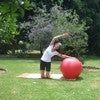Description
About This Video
Transcript
Read Full Transcript
Hi, my name is Ed Tab, and today I'm going to be teaching or talking about a glute activation for your apply these practice, right? So what we're going to be working on is just using a couple of exercises and techniques to switch on these very important gluteal muscles. And the reason, you know, I like to focus on the glutes, firstly, they're really important muscles for, uh, preventing back pain. All right? And they are our main extensors of our bodies. So as we age, we tend to fold further forward and those glutes are really important to keep us upright. Alright, so for better health and better posture, right? And posture definitely adds years onto your life. All right, so you can follow me if you'd like to. I'm going to go through a couple of a little releases and stretches and then into some real glute activation exercises starting from basic to a little bit more, more advanced. All right, so first I'm going to have you lying down on your back supine and I'm going to take my right leg and hugging my knee into my chest.
So I've got my hands behind my right fi so it really important that you have your hands behind your fire and your fingers in today's all right. And just staying nice and relaxed in your upper girdle. I want to get this angle of my thigh towards my chest as tight as possible. All right, so it's going to put a little bit of stretch on the hamstring. Alright, when I lengthen my leg.
So what I'm trying to avoid is as I straighten my leg out, I want that leg to push away. All right, I want to get a little bit of releasing the hamstring and working with, in this case the agonist is going to be my knee extensor, right? So drawing the Niamh close, I use my right quad and I lengthen my leg up and holding it for two counts and then softening the knee again. All right, so we call this active isolated stretching. And again, so I draw enabling, I straighten my leg. Two cons. You should be feeling it just behind the fi all the way up to the cough.
And I'm going to do that one more time. And extending the leg
So from there I'm going to move into a hip flexor stretch. All right. So really what I'm looking for is a bit of a stretch of the rectus femoris and possibly the alien [inaudible], right? So these two muscles in particular can restrict the activation of the glute maximus as well. So it would almost be like a car that's driving with its handbrake, you know, stack on all the time. Right until you release those muscles. All right, the, the car won't or the, the car won't move forward. And in this case, our body, right? So I'm going to lie down onto my back again. And if you have a bed, all right, or a Cadillac to lie on, it would help cause we want to work on the edge. All right? Of something. So I'm going to take my hand on my left leg and I need to press this leg down into my body.
So the reason I pressed this leg down is that it flattens my lumber, so I don't use my extensive of my back when I'm getting the stretch. All right, so from there I'm just going to allow my right leg just to hang over the edge. Alright? And we'll just hold that for a couple of seconds just to allow the hip flexor to release. If you feel comfortable with that, you're going to just lift up and take hold of your foot or your ankle. If you can't reach, you could use a towel or a strap around your foot. And then we're going to gently bring this knee into extension or hip into extension, should I say, and then draw my heel towards my backside, right? Unless we're going to hold this for a couple of cancer, one, two, and then I release. And then I want to go in again.
So I draw heel towards my backside, keeping the pressure on my Shin to press my lower back down into the mat and one, two and release. So just as an option, if you don't have an age to work on, we could also take it into a a kneeling stretch. So I would go onto both knees. All right, I'm going to step my left leg in front, bringing my hands behind me, right? And then from there I'm just going to move into a bit of a hip extension. So again, I'm going to use my glute maximus on my right leg and just pushing off with my leg, right? What you're trying to avoid, those going into the hyperextension. So the more you can hold your abdominals or the navel in to your spine, the better stretch you're going to get on that quadricep. So again, I'd like to keep them short. One, two, and back in. Alright. And then we'll change to the other side.
So I'm just going to spin around just a repeat hand, holding the Phi into your chest, taking the lower back out of extension. Let the leg just hang into hip extension over the edge. If you comfortable with that pipe, right? Then we're going to take hold of the foot and we pull into a little bit of a quad stretch. So two counts. One, two and gentle release. Again, if you struggle to reach, you could always use a small towel. All right.
Or a theraband around the foot and one and two. All right. And I'll go into the kneeling version as well. Again, just to revise that on the other side. So one knee down, opposite foot up and pushing up into a gentle bridge. All right. Keeping my abdominals engaged, getting a good stretch out on the quadricep. One, two and one more time. And pushing up one, two and release. All right, so that's gonna open up the hip joint a little bit. Um, and now we're ready to start. Switching on those gluteal muscles. So from your um, supine position, we're going to turn into prone.
So I'm gonna lie down on the mat
And what I would advise is you try hold that for 30 seconds or slow 10 counts, right? And what we're trying to, to look for here is to see that there is no break in the knee. So when the hamstring takes over, right? And instead of the glute working, the knee would want to go into a little bit of a bend. So I've got a really use my fire muscle to keep my knee absolutely straight and lifting the leg up
We'll give you about 30 seconds.
So classical polities exercise that's been modified slightly. Um, you know, and what we often see in, in the [inaudible] classes is when people are doing the double leg kick or any of the hip extension exercise that they're going to abduction and external rotation. So again, what's happening is the Fascia letter is taking over, um, instead of the gluteus maximus doing its work, um, withhold from the adductors. So what we're going to do is add that your legs, so you're gluing your knees together. You could possibly tie a band around your legs if you feel that it's a struggle to keep the legs together initially. And then we want to bring their legs into hip extension.
Then you should really start feeling the back of your legs waking up. So then we're going to turn over into supine again, or we're going to start with some bridging exercises, right? So just on a very basic level, feet together, knees together, feet, Dorsey, flexed. All right? And the Dorsey flection. Again, we're just eliminating another one of the extensors and that's going to be the gastro muscle. All right? So your calf muscle. So by flexing the feet, we're eliminating the use of the carbs.
We're going to get a little bit more focus in the glutes, right? And we're going to just keep a neutral position of the spine. And from there, gently
And not to confuse this movement with the pelvic. Cool. All right, so this we are doing in neutral because they emphasis here is not on the spine. It's purely on the hip extension. So let's just repeat it one more time.
So when we're doing this next bridge, you just want to pay attention to the level of your hipbones. So trying to keep them quite symmetrical. So I fire up my right glute before I start by just giving a little bit of a squeeze and press up all the way up through your glute. Make sure it's nice and tight there and bringing it back and down. So that's something that you really want to emphasize before you move.
Is that actual tightening of your gluteal muscle. Like we said, there are a couple of compensations that could take place. Number one would just be the hamstring or the lower back, right? So we're going to go up again and we press up using the glute nice and tight and come back and let's change to the other side. So you may have found when you're doing bridges in the past or if you've worked with clients or you as a, um, a client yourself, when you're doing a bridge and you get a hamstring cramp, that's just your hamstring that's taking over. All right? So that's possibly that you're not putting enough emphasis on activating that gluteal muscle. So again, I've got to really think about it.
Squeeze into the glute. I always think of just gently pinching a coin between my two bad cheeks and pressing up through the leg and bring it back and down. I'm just going to repeat it one more time. On this side. You get the hang of it and we're going to press up again and hold and that down for me and relax, right? So what we want to do now is we're going to take her to um, one, one step up. So we're going to take a combination of the stretch we did lying over the end where we pressed the lower back flat into the mat to eliminate the, the back extensors and we get the little bit of hip flexor stretch. Um, and now just putting the emphasis on the bridge.
So same supine position, left knee, how good into my chest, but really pressing it flat this time so that I'm in a little bit of a posterior tilt. Dorsey flection on the right foot and we bridge up from there. Alright, so we restricted right from the quad, right? And obviously the strength of our glutes. So the title, we can squeeze the glute the higher we can go and bring it back down, but not at the expense of the lumbar spine. That's why we have the knee hugging into our chest. So I'm going to repeat that. So I'm going to push up. So again, I would do about five to eight of those and bring it back down to the bottom. So it has changed to the other side. We're giving the knee a good hug into the chest, engaging your glutes for flex so I can drive through my hill and press up and you can definitely feel the difference in the two sides as well.
So my much stronger side here and I'm going to press up, hold that position there, give yourself two counts
And that's going to bring me up into a side plank position. All right, so obviously the weight being on this bottom leg, I'm using my hip abductors, which would be particularly my glute medius working here. And then I'm going to bring that back down. So let's just go ahead and do five of those. So I'm going to go up and back and uh, and this definitely has an effect on the obliques as well. All right, so make no mistake, we've got great shoulder work and oblique work happening, but primarily we are working from the hip abductors right?
So I'll just do that twice more. So we got up and back down and repeat one more time. So pressing up into that side position
Abductors alright, so I'm going to just turn it over to the other side and I'll repeat that sequence. So bottom leg is bent, the top leg is long. So from there, just using your bottom leg and pushing yourself up and lowering yourself down. So just good hip abduction work. All right? So particularly if you playing other sports that require a quick change of direction, right? These hip abductors are really important muscles to prevent us from having injuries, particularly around the hip joint or around the knee area. All right? So if you're a football player and you have a quick step or basketball court or even dawns jump, all right?
All the hip abductor muscles should be pretty strong for hip and knee stability. Okay? And I'll do two more times and pushing up one and back. And the last time and up we go
So I would use that little sequence, um, every morning. Alright. Right before I do my politeness workout or before I do any kind of sporting activity. So it just preps those hip muscles, particularly the glutes. All right. For better support, for a more upright posture and for a safe back during your practice. All right. So thank you very much and thanks for your time. And we done.
Tips for Teachers: Keep It Fresh! Exercise Tutorials
Comments
You need to be a subscriber to post a comment.
Please Log In or Create an Account to start your free trial.













































